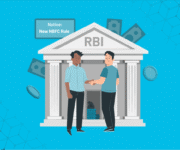The launch of the Unified Payments Interface (UPI) network in India in 2016 revolutionised the payments domain. This system enabled instant and secure payments by anyone with a mobile phone and bank account.
Since then, digital payments have become the go-to mode of payments across economic strata.
The financial year 2022 to 2023 recorded digital payments to the tune of $ 114 billion in India, a significant increase over the previous three years. The transaction value of digital payments is expected to reach $254.60 billion by the end of 2024.
The growth of digital payments has spearheaded growth in a number of domains, such as the lending industry. Let’s understand the impact of digital payments on the lending industry and how lenders can leverage digital lending software to scale faster.
What Is Digital Lending Software?
Digital lending software is a data-driven, tech-enabled solution that automates the entire loan management workflow, from loan origination and underwriting to collection delinquency management.
In other words, the solution encompasses the end-to-end process of a borrower’s timeline, from when they apply for a loan to when it is fully paid off.
The growing adoption of digital payments has enabled businesses to scale faster, and in turn, they require access to credit to power growth.
In this scenario, automating the loan management process helps lenders respond to real-time industry needs faster while simultaneously scaling their operations and managing risk efficiently.
Impact of Digital Payments on Lending Landscape
Digital payments have helped lenders disrupt the industry in several ways. Here’s a peek at paradigm shifts:
1. Instant Loan Disbursals
Digital transformation has helped lenders reduce the time frame between loan applications and loan disbursals. The use of lending software has helped lenders automate the application and underwriting process, making it more efficient.
On the other hand, when a loan is approved, lenders can make instant credit payouts to the borrower by leveraging digital payments.
2. Impact on the MSME Sector
The Micro, Small and Medium Enterprise (MSME) sector in India is traditionally underbanked and lacks access to credit.
According to reports, only 250 lakh of India’s 630 lakh MSMEs have access to credit. The credit gap among MSMEs is estimated to amount to INR 33 trillion.
Digital payments have been a game-changer in this context, enabling MSMEs to expand their businesses across the country due to secure and instant payments.
The adoption of digital lending software enables lenders to bridge the gap by analysing the real-time cash flows of MSMEs, many of whom are first-time borrowers with no assets. This tool can predict a borrower’s ability to repay loans based on their financial habits and revenue history.
3. Multiple Channels for Loan Repayments
Borrowers can use their mode of choice to repay their EMIs on time. They get to choose between UPI apps, net banking, credit cards, debit cards, and auto-debit, to name a few, to pay the loans on time and avoid paying penalties.
Superior lending software enables seamless integration of various payment apps and payment modes to build an inclusive experience.
4. Secure, Effortless Payments
The guarantee of a secure mode of payment has made digital payments even more popular. UPI has introduced a number of authentication methods that have enhanced the security of such transactions.
Popular methods include two-factor authentication, biometric authentication, Card Verification Value (CVV), and tokenisation, which payment gateways generally use.
5. Higher ROI
Lenders that leverage lending software can scale up much faster since the entire loan management workflow has been digitised and made more efficient.
Lenders can also run with lean business teams and personalise their solutions for a wide spectrum of borrower profiles.
Top Features of Digital Lending Software
Here’s a closer look at the various features and advantages of automated digital lending software:
1. Document Identification Framework
Digital lending software leverages optical character recognition (OCR) to extract data from multiple data sources, such as bank statements, income statements, and invoices.
The software automates and expedites the extraction of data from over 700 file formats, thus saving time and resources. It also significantly reduces errors and omissions.
2. Super Bank Statement Analysis
Bank statements are one of the most significant financial documents offering detailed data on a borrower’s income, expenses, liabilities, debt, and financial habits.
Digital lending software like Finezza enables in-depth analysis of bank statements by segregating all transactions into over 60 inflow and outflow categories within minutes, thus enabling lenders to get a comprehensive picture of cash flows.
3. Risk Assessment & Fraud Detection Tools
Python, AI, and machine learning enable digital lending software to detect unusual patterns in transactions, which can point to fraudulent transactions.
The software can also detect minute inconsistencies in documentation to expose fraudulent documents and identity theft.
4. Automated Debt Recovery Mechanisms
Traditionally, lenders respond to debt recovery as a separate silo, often outsourcing the role to agencies. However, this approach alienates customers and is more expensive and ineffective in the long term.
The adoption of digital lending software is a game-changer for debt recovery, leveraging data to understand a borrower’s real-time needs.
Based on the data, loan repayments and conditions can be automatically adjusted to support faster repayment. Provisions of optimal conditions, such as customised communication and more payment options, can nudge borrowers to repay on time and faster.
Key Takeaway
Digital payments have influenced the economy in diverse ways, leading to growth in eCommerce, embedded finance, and ease of payments in the lending domain.
Coupled with the adoption of automated digital lending software, lenders can take advantage of expediting the lending life cycle to convert more borrowers into customers and scale up their business.
Finezza offers a comprehensive set of tools and solutions to manage your lending portfolio. Our end-to-end lending management solutions are trusted by brands like ftcash, Hiranandani Financial Services, gromor Finance, and UC Inclusive Credit, to name a few.
Finezza’s intuitive bank statement analysis software analyses bank statements quickly and accurately and detects potential fraud.
Book a demo to know more.




Leave a Reply